The double-breasted, cigar-chewing gentlemen who gathered in the sumptuous rooms of the Fifth Avenue Hotel were occasional connoisseurs of New York City history, and in particular, these amateur historians spoke of the very street corner where their hotel stood.
Before Madison Square, when the area was a barren parade ground, one Corporal Thompson opened a roadhouse and stagecoach station in the area that was to become 23rd Street and and Fifth Avenue.
Many spoke fondly of Thompson’s establishment, called Madison Cottage, because they remembered the place as young boys. They recalled the area’s rural quality, with carved rectangular blocks carved into the land and a dirt-road Broadway meandering north.
But that was the 1840s.
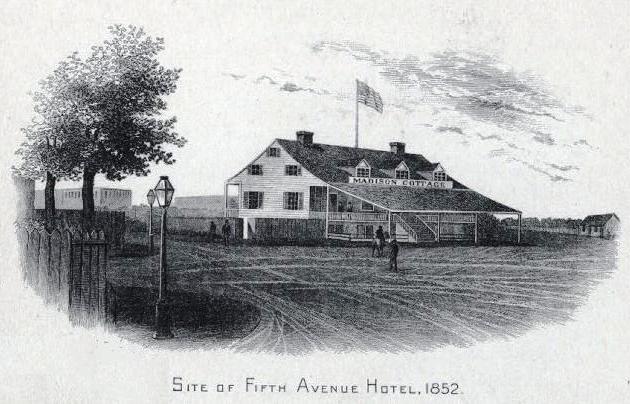
Forty years later, Madison Square Park was the center of New York, a focal point of class, business and luxury that stretched south to Union Square, through that attractive collection of fine stores known as Ladies Mile, and up Fifth Avenue into the fabulous mansions of the rich.
And dead center of all that activity was the Fifth Avenue Hotel, not only the “finest [hotel] in this metropolis”, the “leading hotel of the world ,” but quite simply one of the most surprising stages for American politics of the mid and late 19th century.
New York’s Hotel Revolution
Hotels were fast becoming the center of New York life from at least the days of the Astor House, located near City Hall, in the 1830s. Within two decades, trendy new hotels (such as the St. Nicholas and the Metropolitan) spread up along Broadway and eventually clustered around Union Square.
By the Civil War, the thrust of New York society was so defined by them that Confederate conspirators tried setting fire to a several of them.
The Fifth Avenue Hotel opened in 1859, the venture of wealthy merchant Amos Richards Eno, who accurately gambled that the center of city commerce would soon settle at 23rd Street. So confident a speculator was Eno that he moved from his brownstone at 74 Broadway (the first New York brownstone, he claimed) to a massive home nearby the hotel.
Some thought it unwise to build so far north, and when workers unearthed dozens of skeletons during construction — the area once being a potter’s field — the corner was even considered cursed. Eno defied the naysayers, pouring his wealth into the hotel to make it the most modern, most luxurious accommodation of the day.
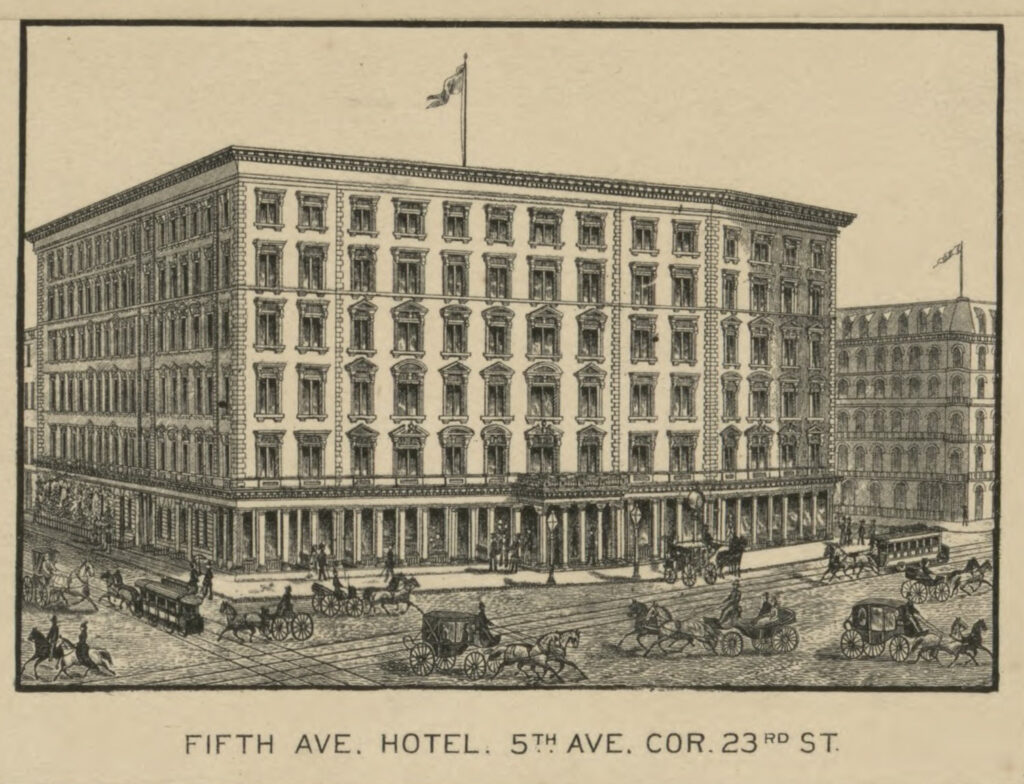
A Gilded Age Confection
The Italian exterior was awash in five stories of imported marble, while austere, carpeted interiors of French design drew comparisons to European palaces.
Guests enjoyed reading rooms, a luxurious bar, a barber shop, a dedicated telegraph office, and a variety of dining and drawing rooms, not to mention the first passenger elevator ever built in the United States, a steam-powered monstrosity whisking passengers to their floor.
The private quarters were soundproofed, fixtured with the modern innovations in plumbing, and lavishly decorated, becoming to many “the safest, the most healthy and most comfortable hotel in the world.“
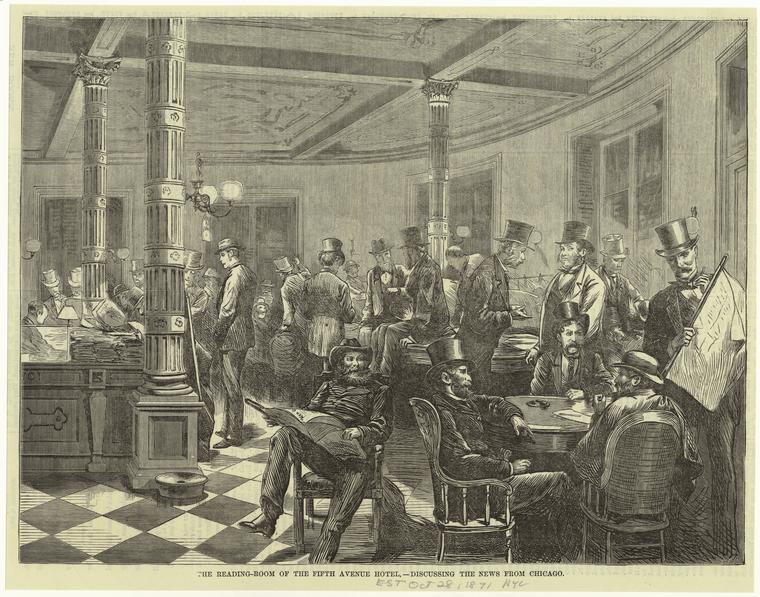
Wheeling and Dealing
As the finest hotel in the city in the post Civil War years, it naturally became a magnet for politicians and financiers. Of all the ‘backrooms’ of American politics, none were as gleaming as the Fifth Avenue.
Bankers huddled in the legendary ‘parlor D. R.’ during the tense days of the financial panic of 1873. In particular, the hotel became a de facto headquarters for New York Republicans.
While often secondary to the city’s Democrats — this being the era of Tammany Hall‘s swelling power — Republicans were frequently in control of state government, and the Fifth Avenue Hotel became a smoky center of political wheeling and dealing.
During the 1870s, New York republicans became national power brokers and frequently hashed out crises here at the Fifth Avenue.
In the years before the Waldorf-Astoria, presidents and dignitaries all stayed here during visits. Seamier political maneuvers took place in the chambers of prominent politicians who held court here, including the inimitable Roscoe Conkling (at left), senator of New York and leader of the Republican faction known as the Stalwarts.
National Influence
When fractured Republicans at their convention in 1880 nominated non-Stalwart James Garfield for president, the nominee had to basically grovel for their support by symbolically ‘kissing the ring’ of the Stalwarts during a visit to the Fifth Avenue Hotel, partially agreeing to their system of patronage and taking Conkling ally Levi Morton as a member of his cabinet. (Garfield later backed out on this arrangement.)
Another frequent guest here was Chester A. Arthur, Garfield’s eventual vice president. When Arthur became president after Garfield’s assassination by Charles Guiteau (who had himself wandered the hotel’s hallways in delusion), he would set up his entire administration here during visits to his adopted city.
By the 1890s, a corridor of the hotel known as the ‘Amen Corner‘ was a famous congregation spot for Republican political bosses and reporters. As they frequently powwowed here on Sundays, gatherers would caustically shout ‘Amen!’ during heated discussions.
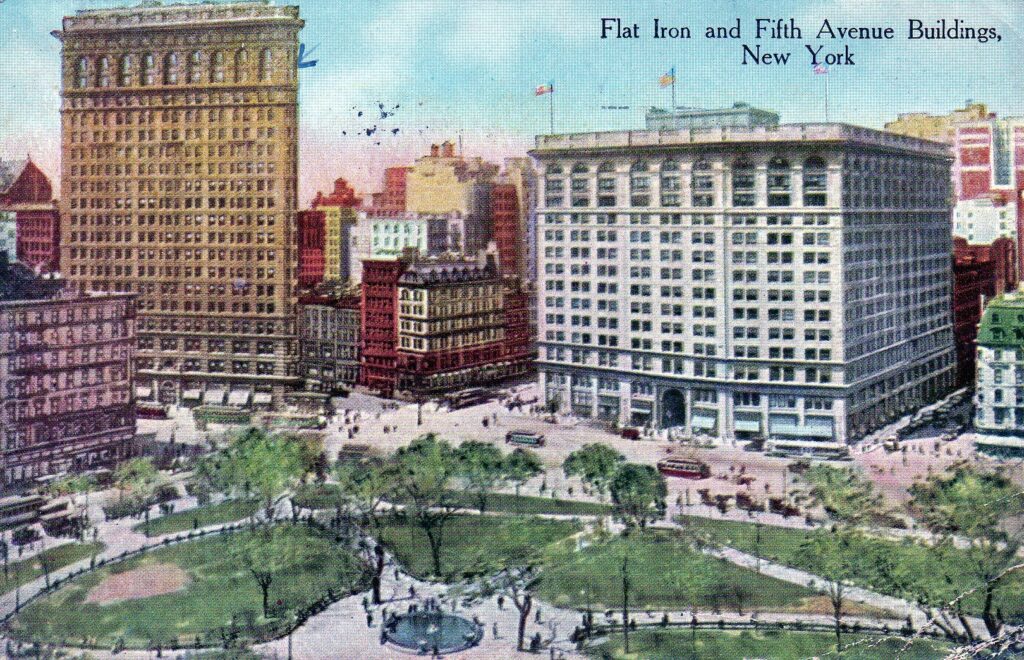
Checking Out
The hotel became a magnet for shenanigans of all varieties. In 1893, a couple hundred proponents of a U.S. monetary silver standard erupted into a riot that included two U.S. senators.
The bank robber Robert Montague was arrested here in 1896 thanks to a tip-off from a chambermaid. An early vestige of baseball’s National League met here annually, and the national pool competitions were held in the hotel’s billiard room.
By the new century, of course, the locus of New York activity was hastily moving uptown, and the Fifth Avenue Hotel was deemed a relic, even as a brand new structure across the street — the Flatiron Building — was being proclaimed the finest building in the city.
In 1908 the Fifth Avenue Hotel was torn down and replaced by the 16-story Toy Center (called the Fifth Avenue Building back in the day), the epicenter of toy manufacturing for much of the 20th century.

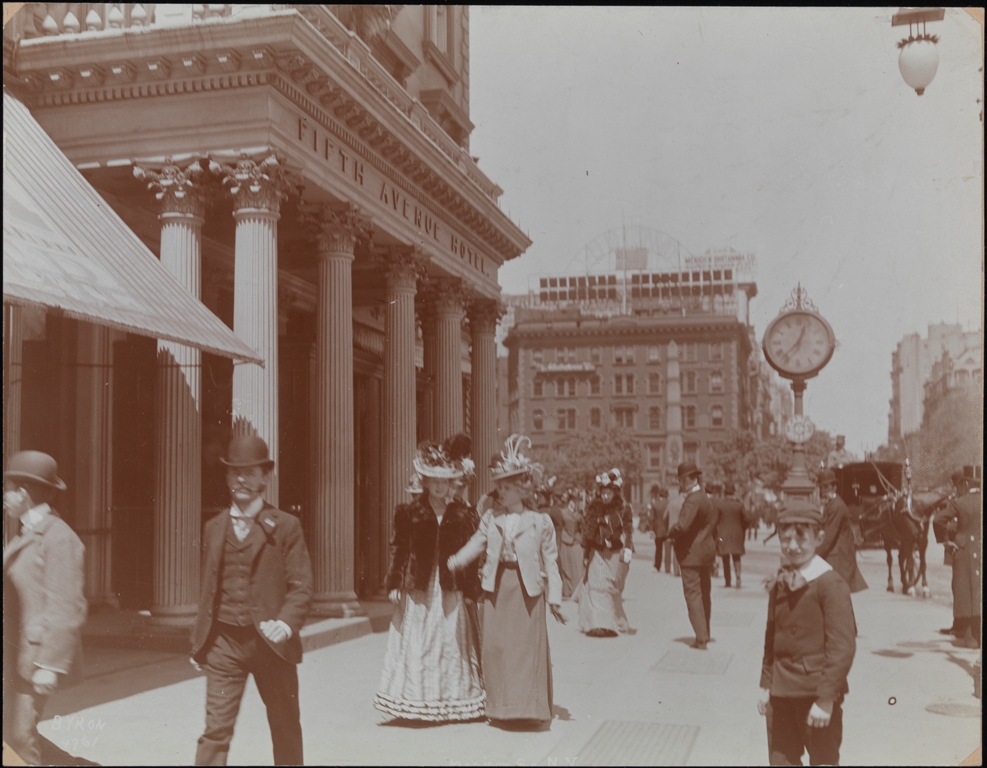
11 replies on “The Fifth Avenue Hotel: Opulence, glamour and power on Madison Square”
Anyone interested in images of the hotel, the Hippodrome, and the House of Refuge, etc., should check out this blog post about the history of Madison Square from the Museum of the City of New York’s blog:
http://mcnyblog.org/2011/12/13/the-evolution-of-madison-square-from-potters-field-to-eataly/
The Amen Corner was not really showing jubilation in discourse, but in the sycophancy and toadying of low rankers on the political totem pole, who would agree with the boss’s comments by agreeing, “Amen”.
Today the Amen Corner still means those who agree with the boss and don’t think for themselves.
Thanks for this great posting. My parents were married here in the 1950s and I needed some info in addition to Wikipedia for a family history project. I will be sure to provide credit to this blog.
My parents were married in NYC in September of 1944. They have a postcard and welcome note from this hotel at this address. How could that be if it was torn down in 1908?
I think the confusion may be on the naming of yet another hotel on the NW corner of 5th Ave & 10th St as “The 5th Avenue Hotel.” How long that location held that name or when it first received the name, I don’t know.
But, in my many years here in the East Village, that’s how I knew it.
Hello! Just a gentle correction that Amos Richards Eno may have lived at 74 Broadway but in 1895 moved to a Washington Square mansion at 32 Fifth, which he loved dearly and bequeathed to his son, Amos Eno Jr.
http://daytoninmanhattan.blogspot.com/2017/11/the-lost-hart-m-shiff-mansion-32-fifth.html
https://www.throughthehourglass.com/2019/03/last-of-washington-square-millionaires.html
As a proud former tenant of the Fifth Ave Building (FAB)TOY CENTER, I very much enjoyed reading your article.
I had began my career in the construction industry exclusively renovating showrooms of toy manufacturers before actually entering the toy industry myself.
As a result I became very knowledgeable of the entire building and its structure.
When the industry was displaced, treasure seekers were removing every trinket of identification (one evening someone even removed all the brass FAB logos that adorned every elevator!) that was going to be demolished in the new renovations.
The only thing I was able to salvage was an old brass door knob with the FAB logo embossed on the face.
It’s a heavy paper weight currently still in use in my den.
A reminder of a Building that has occupies large space in NYC history.
Actually, the #24 5th Ave building that I was thinking of is at the NW corner of 5th Ave & 9th St. It appears to be a luxury apartment operation now.
But I swear it was a hotel that got converted.
The 5th Avenue Hotel was operated by Hitchcock, Darling & Co. Alfred Darling’s was married to Lydia Darling. Lydia Darling’s sister, Hannah Nye, married Gardner Wetherbee. Gardner Wetherbee of Hawk and Wetherbee, former proprietors of the Windsor Hotel, that later infamously burned down on St. Patrick’s Day 1899, was the proprietor of the Hotel Manhattan at the NW corner of Madison Avenue and 42nd. At the time of it’s construction, the Hotel Manhattan was touted as the tallest hotel in the world and was lavishly adorned. It was designed by Henry J. Hardenbergh who also designed the Waldorf-Astoria among others. The Transportation Club was located on the entire 13th floor of the Hotel Manhattan.
The 19th century Manhattan hotel scene appeared to be a closely connected group.
I believe my husband’s great grandfather lived at the 5th Avenue Hotel when he immigrated to NYC around 1866. I can’t imagine that he could afford to live in a high end hotel back then. I also saw on a census record, that he worked as a porter. I wonder if the hotel allowed employees to live in the hotel. Would love to hear from anyway who has any info.
My father had a small band at the hotel
Bert Gross lead and played the violin with the orchestra